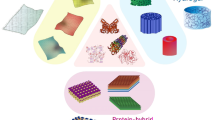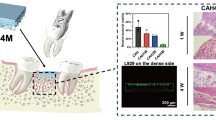Abstract
The aim of this work is to assess the behavior of biocomposites (CPSs) in regard to the generation of biogenic hydroxyapatite and also their degradation depending on the concentration of cross-linker agent, pH, and ionic strength. The development of these composites with potential application in bone tissue regeneration is based on alginate and synthetic nano-hydroxyapatite (nano-HA), which was used as a cross-linker agent. The CPSs showed the capability to develop biogenic hydroxyapatite when they were incubated in simulated body fluid (SBF) depending on the incubation time and concentration of the linker. These results were analyzed by x-ray diffraction (XRD), Fourier transform infrared (FT-IR), and scanning electron microscopy (SEM). Furthermore, the CPSs have shown resistance to the degradation (demonstrated by swelling and dissolution tests) when the mentioned conditions were modified. Finally, the development of a liquid crystalline phase within the composites, which contributes to reinforce their structure, is a novel finding in this study. This behavior has been shown by means of optical microscopy (OM) with crossed polaroids. Thus, these composites displayed promising results to be used as bone filling materials in the future.







Similar content being viewed by others
References
Dimitriou R, Mataliotakis GI, Angoules AG, et al. (2011) Complications following autologous bone graft harvesting from the iliac crest and using the RIA: a systematic review. Injury 42:S3–S15. https://doi.org/10.1016/j.injury.2011.06.015
Giannoudis PV, Dinopoulos H, Tsiridis E (2005) Bone substitutes: an update. Injury 36:S20–S27. https://doi.org/10.1016/j.injury.2005.07.029
D’Elía NL, Mathieu C, Hoemann CD, et al. (2015) Bone-repair properties of biodegradable hydroxyapatite nano-rod superstructures. Nano 7:18751–18762. https://doi.org/10.1039/C5NR04850H
Tautzenberger A, Kovtun I (2012) Nanoparticles and their potential for application in bone. Int J Nanomedicine 7:4545–4557. https://doi.org/10.2147/IJN.S34127
D’Elía NL, Gravina AN, Ruso JM, et al. (2013) Manipulating the bioactivity of hydroxyapatite nano-rods structured networks: effects on mineral coating morphology and growth kinetic. Biochim Biophys Acta - Gen Subj 1830:5014–5026. https://doi.org/10.1016/j.bbagen.2013.07.020
Cai Y, Yu J, Kundu SC, Yao J (2016) Multifunctional nano-hydroxyapatite and alginate/gelatin based sticky gel composites for potential bone regeneration. Mater Chem Phys 181:4–10. https://doi.org/10.1016/j.matchemphys.2016.06.053
Wei G, Ma PX (2004) Structure and properties of nano-hydroxyapatite/polymer composite scaffolds for bone tissue engineering. Biomaterials 25:4749–4757. https://doi.org/10.1016/j.biomaterials.2003.12.005
Kokubo T, Hanakawa M, Kawashita M, et al. (2004) Apatite deposition on calcium alginate fibres in simulated body fluid. J Ceram Soc Jpn 112:363–367. https://doi.org/10.2109/jcersj.112.363
Clarke B (2008) Normal bone anatomy and physiology. Clin J Am Soc Nephrol 3(Suppl 3):S131–S139. https://doi.org/10.2215/CJN.04151206
Lin H-R, Yeh Y-J (2004) Porous alginate/hydroxyapatite composite scaffolds for bone tissue engineering: preparation, characterization, andin vitro studies. J Biomed Mater Res 71B:52–65. https://doi.org/10.1002/jbm.b.30065
Ilie A, Ghiţulică C, Andronescu E, et al. (2015) New composite materials based on alginate and hydroxyapatite as potential carriers for ascorbic acid. Int J Pharm 510:501–507. https://doi.org/10.1016/j.ijpharm.2016.01.025
Zhang J, Wang Q, Wang A (2010) In situ generation of sodium alginate/hydroxyapatite nanocomposite beads as drug-controlled release matrices. Acta Biomater 6:445–454. https://doi.org/10.1016/j.actbio.2009.07.001
Rwei SP, Nguyen TA (2015) Formation of liquid crystals and behavior of LCST upon addition of xanthan gum (XG) to hydroxypropyl cellulose (HPC) solutions. Cellulose 22:53–61. https://doi.org/10.1007/s10570-014-0469-y
Rwei SP, Nguyen TA, Chien-Jung Lee J, Chiang WY (2015) Liquid crystal formation and rheological study in aqueous blends of xanthan/acacia gum. Food Hydrocoll 46:52–58. https://doi.org/10.1016/j.foodhyd.2014.12.013
Quirolo ZB, Benedini LA, Sequeira MA, et al. (2014) Understanding recognition and self-assembly in biology using the chemist’s toolbox. Insight into medicinal chemistry. Curr Top Med Chem 14:730–739. https://doi.org/10.2174/1568026614666140118220825
Melville AJ, Rodríguez-Lorenzo LM, Forsythe JS (2008) Effects of calcination temperature on the drug delivery behaviour of ibuprofen from hydroxyapatite powders. J Mater Sci Mater Med 19:1187–1195. https://doi.org/10.1007/s10856-007-3185-4
Nayak A, Laha B, Sen K (2011) Development of hydroxyapatite-ciprofloxacin bone-implants using “quality by design”. Acta Pharma 61:25–36. https://doi.org/10.2478/v10007-011-0002-x
Öztürk E, Agalar C, Keçeci K, Denkbaş EB (2006) Preparation and characterization of ciprofloxacin-loaded alginate/chitosan sponge as a wound dressing material. J Appl Polym Sci 101:1602–1609. https://doi.org/10.1002/app.23563
Dong Z, Wang Q, Du Y (2006) Alginate/gelatin blend films and their properties for drug controlled release. J Memb Sci 280:37–44. https://doi.org/10.1016/j.memsci.2006.01.002
Islan GA, Mukherjee A, Castro GR (2015) Development of biopolymer nanocomposite for silver nanoparticles and ciprofloxacin controlled release. Int J Biol Macromol 72:740–750. https://doi.org/10.1016/j.ijbiomac.2014.09.020
Devanand Venkatasubbu G, Ramasamy S, Ramakrishnan V, Kumar J (2011) Hydroxyapatite-alginate nanocomposite as drug delivery matrix for sustained release of ciprofloxacin. J Biomed Nanotechnol 7:759–767. https://doi.org/10.1166/jbn.2011.1350
Salomonsen T, Jensen HM, Larsen FH, et al. (2009) Alginate monomer composition studied by solution- and solid-state NMR—a comparative chemometric study. Food Hydrocoll 23:1579–1586. https://doi.org/10.1016/j.foodhyd.2008.11.009
Rhim J-W (2004) Physical and mechanical properties of water resistant sodium alginate films. LWT - Food Sci Technol 37:323–330. https://doi.org/10.1016/j.lwt.2003.09.008
Kokubo T, Hanakawa M, Kawashita M, et al. (2004) Apatite-forming ability of alginate fibers treated with calcium hydroxide solution. J Mater Sci Mater Med 15:1007–1012. https://doi.org/10.1023/B:JMSM.0000042686.44977.81
Kokubo T, Kushitani H, Sakka S, et al (1990) Solutions able to reproduce in vivo surface-structure changes in bioactive glass-ceramic A-W3. J Biomed Mat Res 24:721–734. https://doi.org/10.1002/jbm.820240607
Padmanabhan SK, Balakrishnan A, Chu MC, et al. (2009) Sol-gel synthesis and characterization of hydroxyapatite nanorods. Particuology 7:466–470. https://doi.org/10.1016/j.partic.2009.06.008
Sangeetha K, Thamizhavel A, Girija EK (2013) Effect of gelatin on the in situ formation of alginate/hydroxyapatite nanocomposite. Mater Lett 91:27–30. https://doi.org/10.1016/j.matlet.2012.09.054
Xie M, Olderoy M, Andreassen JP, et al. (2010) Alginate-controlled formation of nanoscale calcium carbonate and hydroxyapatite mineral phase within hydrogel networks. Acta Biomater 6:3665–3675. https://doi.org/10.1016/j.actbio.2010.03.034
Pleshko N, Boskey A, Mendelsohn R (1991) Novel infrared spectroscopic method for the determination of crystallinity of hydroxyapatite minerals. Biophys J 60:786–793. https://doi.org/10.1016/S0006-3495(91)82113-0
Ruso JM, Verdinelli V, Hassan N, et al. (2013) Enhancing CaP biomimetic growth on TiO 2 cuboids nanoparticles via highly reactive facets. Langmuir 29:2350–2358. https://doi.org/10.1021/la305080x
Zhang S (2013) Hydroxyapatite coatings for biomedical applications. CRC Press Taylor and Francis Group, London,
Andersen T, Strand BL, Formo K, et al (2012) Alginates as biomaterials in tissue engineering In: Rauter AP (ed). Carbohydrate Chemistry: Chemical and Biological Approaches. The Royal Society of Chemistry 37, Cambridge, pp 227–258
Xu JB, Bartley JP, Johnson RA (2003) Preparation and characterization of alginate hydrogel membranes crosslinked using a water-soluble carbodiimide. J Appl Polym Sci 90:747–753. https://doi.org/10.1002/app.12713
Topuz F, Henke A, Richtering W, Groll J (2012) Magnesium ions and alginate do form hydrogels: a rheological study. Soft Matter 8:4877–4881. https://doi.org/10.1039/c2sm07465f
Melvik JE, Dornish M (2004) Fundamentals of cell immobilisation biotechnology. Fundam Cell Immobil Biotechnol. https://doi.org/10.1007/978-94-017-1638-3
Ingar Draget K, Ostgaard K, Smidsrod O (1990) Homogeneous alginate gels: a technical approach. Carbohydr Polym 14:159–178. https://doi.org/10.1016/0144-8617(90)90028-Q
Turco G, Marsich E, Bellomo F, et al (2009) Alginate/hydroxyapatite biocomposite for bone ingrowth: A Trabecular Structure With High And Isotropic Connectivity. Biomacromol 10:1575–1583. https://doi.org/10.1021/bm900154b
Reis CP, Ribeiro AJ, Neufeld RJ, V F (2006) Alginate microparticles as novel carrier for oral insulin delivery. Biotechnol Bioeng 96:977–989
Benavides S, Villalobos-Carvajal R, Reyes JE (2012) Physical, mechanical and antibacterial properties of alginate film: effect of the crosslinking degree and oregano essential oil concentration. J Food Eng 110:232–239. https://doi.org/10.1016/j.jfoodeng.2011.05.023
Haug AL, Larsen BS (1963) The degradation of alginates at different pH values. Acta Chem Scand 17(5):1466–1468. https://doi.org/10.3891/acta.chem.scand.17-1466
Williams PA, Phillips GO (2004) Gums and stabilisers for the food industry 12. The royal society of chemistry, thomas graham house, science park, milton road, Cambridge. https://doi.org/10.1039/9781847551214
Nakamura K, Hatakeyama T, Hatakeyama H (1991) Formation of the glassy state and mesophase in the water–sodium alginate system. Polym J 23:253–258. https://doi.org/10.1295/polymj.23.253
Ureña-Benavides EE, Ao G, Davis VA, Kitchens CL (2011) Rheology and phase behavior of lyotropic cellulose nanocrystal suspensions. Macromolecules 44:8990–8998. https://doi.org/10.1021/ma201649f
Ureña-Benavides EE, Brown PJ, Kitchens CL (2010) Effect of jet stretch and particle load on cellulose nanocrystal-alginate nanocomposite fibers. Langmuir 26:14263–14270. https://doi.org/10.1021/la102216v
Desplanques S, Grisel M, Malhiac C, Renou F (2014) Stabilizing effect of acacia gum on the xanthan helical conformation in aqueous solution. Food Hydrocoll 35:181–188. https://doi.org/10.1016/j.foodhyd.2013.05.009
Lee KY, M DJ (2012) Alginate: properties and biomedical applications. Prog Polym Sci 37:106–126. https://doi.org/10.1016/j.progpolymsci.2011.06.003.Alginate
Grant GT, Morris ER, Rees DA, et al. (1973) Biological interactions between polysaccharides and divalent cations: the egg-box model. FEBS Lett 32:195–198. https://doi.org/10.1016/0014-5793(73)80770-7
Wolnik A, Albertin L, Charlier L, Mazeau K (2013) Probing the helical forms of Ca2+-guluronan junction zones in alginate gels by molecular dynamics 1: duplexes. Biopolymers 99:562–571. https://doi.org/10.1002/bip.22216
Sugawara E, Nikaido H (2009) Alginates: biology and applications. Antimicrob Agents Chemother. https://doi.org/10.1007/978-3-540-92679-5
Zhang C, Li C, Huang S, et al. (2010) Self-activated luminescent and mesoporous strontium hydroxyapatite nanorods for drug delivery. Biomaterials 31:3374–3383. https://doi.org/10.1016/j.biomaterials.2010.01.044
Venkatesan J, Nithya R, Sudha PN, Kim S-K (2014) Chapter four—role of alginate in bone tissue engineering. Adv Food Nutr Res 73. https://doi.org/10.1016/B978-0-12-800268-1.00004-4
Benedini L, Messina PV, Palma SD, et al. (2012) The ascorbyl palmitate-polyethyleneglycol 400-water system phase behavior. Colloids Surf B Biointerfaces 89:265–270. https://doi.org/10.1016/j.colsurfb.2011.09.030
Ullio Gamboa GV, Benedini LA, Schulz PC, Allemandi DA (2016) Phase behavior of ascorbyl palmitate coagels loaded with oligonucleotides as a new carrier for vaccine adjuvants. J Surfactant Deterg 19:747–757. https://doi.org/10.1007/s11743-016-1816-9
Funding
The authors acknowledge the support from Universidad Nacional del Sur (PGI 24/Q064) and Concejo Nacional de Investigaciones Científicas y Técnicas de la República Argentina (CONICET, PIP 11220130100100CO). Paula Messina and Luciano Benedini are researchers of CONICET.
Author information
Authors and Affiliations
Corresponding author
Ethics declarations
Conflict of interest
The authors declare that they have no conflicts of interest.
Electronic supplementary material
ESM 1
(DOCX 1362 kb)
Rights and permissions
About this article
Cite this article
Benedini, L., Placente, D., Pieroni, O. et al. Assessment of synergistic interactions on self-assembled sodium alginate/nano-hydroxyapatite composites: to the conception of new bone tissue dressings. Colloid Polym Sci 295, 2109–2121 (2017). https://doi.org/10.1007/s00396-017-4190-x
Received:
Revised:
Accepted:
Published:
Issue Date:
DOI: https://doi.org/10.1007/s00396-017-4190-x




